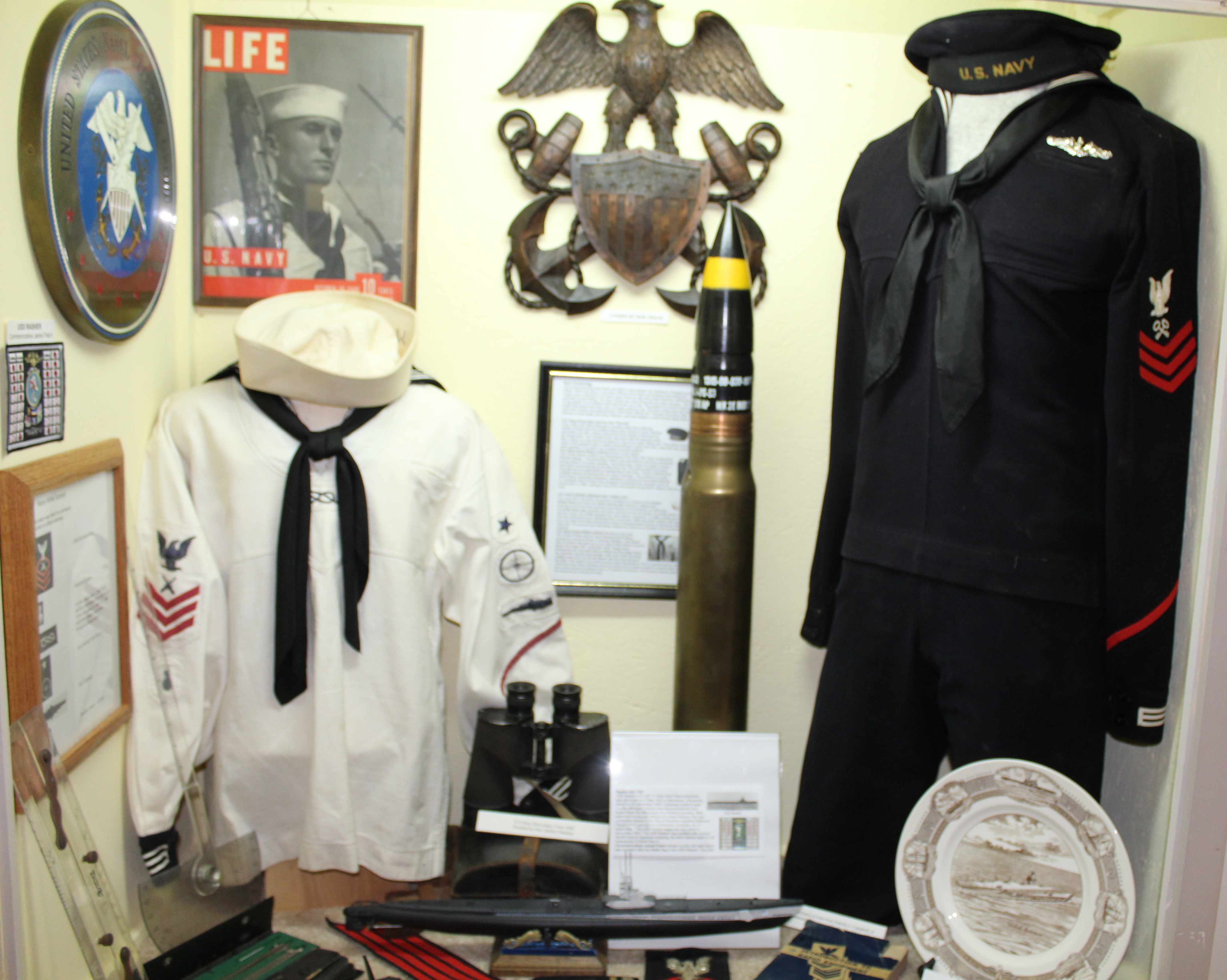Navy Terminology
The various services have Rank and that is used whether the individual is Enlisted or an Officer. Not in the Navy, in the Navy Officers have Rank and Enlisted have Rating (E1 - E9). It gets more confusing to non-Navy types when we talk about Rate (what the individual's specialty is) and Rating (what the individuals pay grade is). The Navy hardly ever does things like the other services.
U.S. Navy Dress Blue Service Hat "Flat Hat"
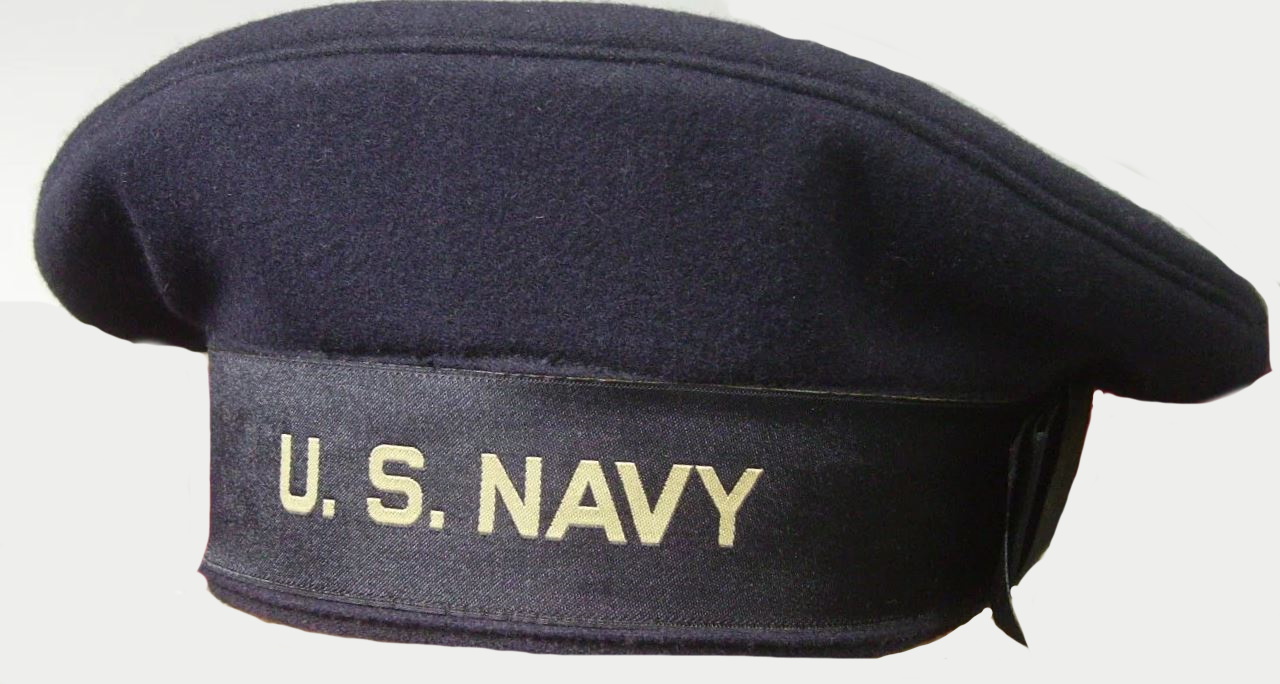
From 1852 until 1962 (although in practice rarely worn after the middle of World War II), enlisted sailors were issued a round, flat blue wool sailor hat with a ribbon around the band similar to that worn by the Royal Navy. The "Donald Duck" was worn with the Service Dress Blue uniform on more formal occasions in lieu of the white "Dixie cup." The ribbon carried the name of the wearer's ship or station embroidered in gold until 1941, when this was replaced with a generic "U.S. Navy" as a wartime security measure.
Dress Blues uniform
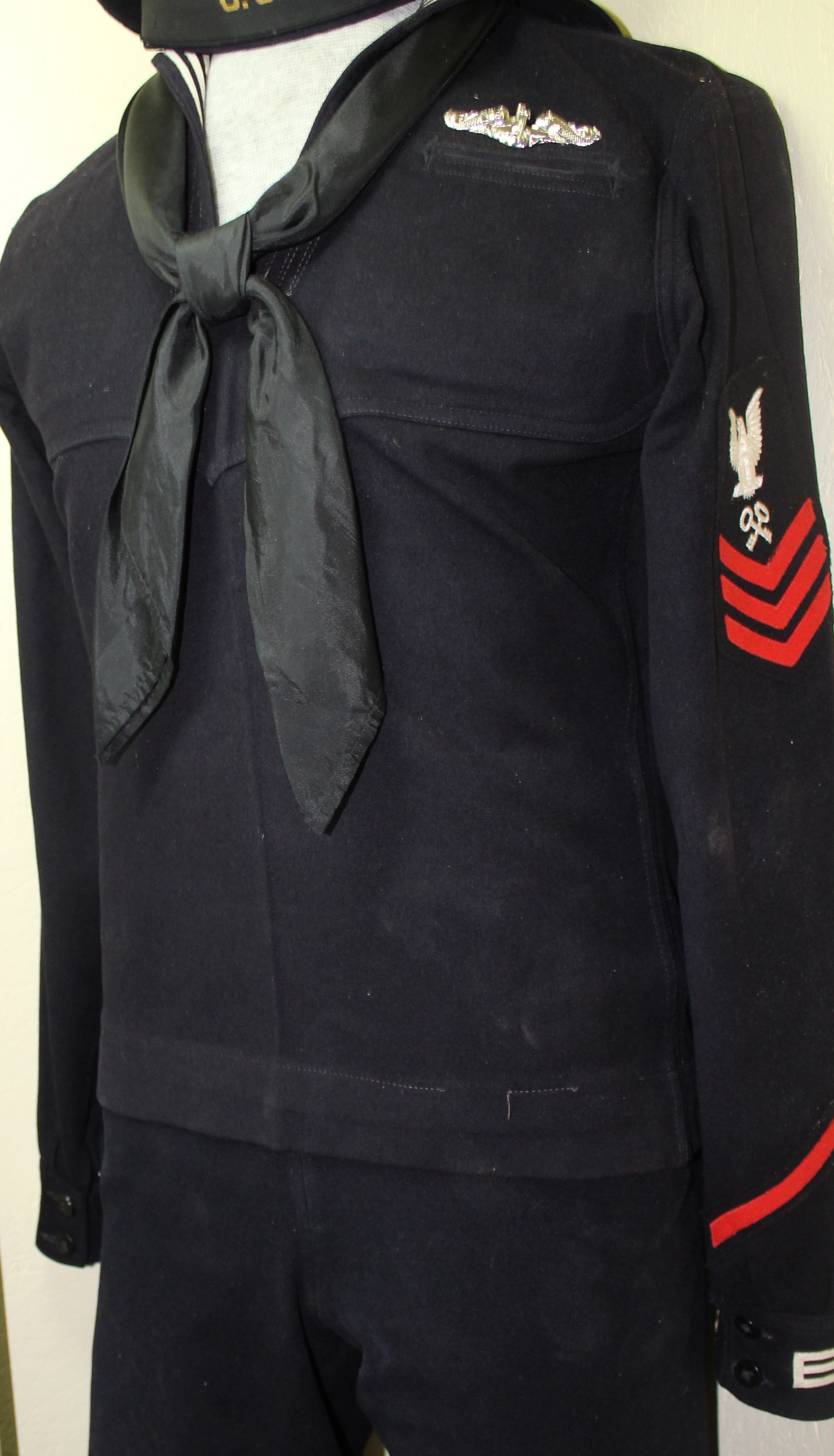
The "Dress Blues" uniform is a Storekeeper First Class "E6" with a "Submarine Warfare Badge" worn by seaman Lundgren who served on the USS Gainard. The Dress Blue uniform was intended for full dress occasions, during winter or in colder climates. The Dress Blue uniform is made of heavy wool and is accompanied by the Dress Blue Cap. The pants would have been very tight and are adjustable by drawstrings in the back. The fly is attached by multiple buttons all bearing the U.S. Navy markings. Blue Uniform has undergone remarkably few changes since its introduction in 1864, making it one of the most easily recognizable military uniforms of all time. The uniform is on loan from Patrick Campbell, Hueytown, Alabama in memory of his brother Michael S. Campbell.
U.S. NAVY WHITE SERVICE HAT "DIXIE CUP"

For more than 130 years, the primary headgear for Sailors in the United States Navy has been the white service hat, dubbed a “Dixie Cup” because of its more-than-passing resemblance to the drinking cup (although the white Navy cap predates the paper product by over 20 years). Currently made from 100-percent cotton, the white service hat—also called a “squid lid. In 1866, a white sonnet straw hat was authorized as an additional item. During the 1880s the white "sailor's hat" appeared as a low rolled brim high-domed item made of wedge-shaped pieces of canvas to replace the straw hat. The canvas was eventually replaced by cotton as a cheaper more comfortable material.
U.S. Navy Dress White
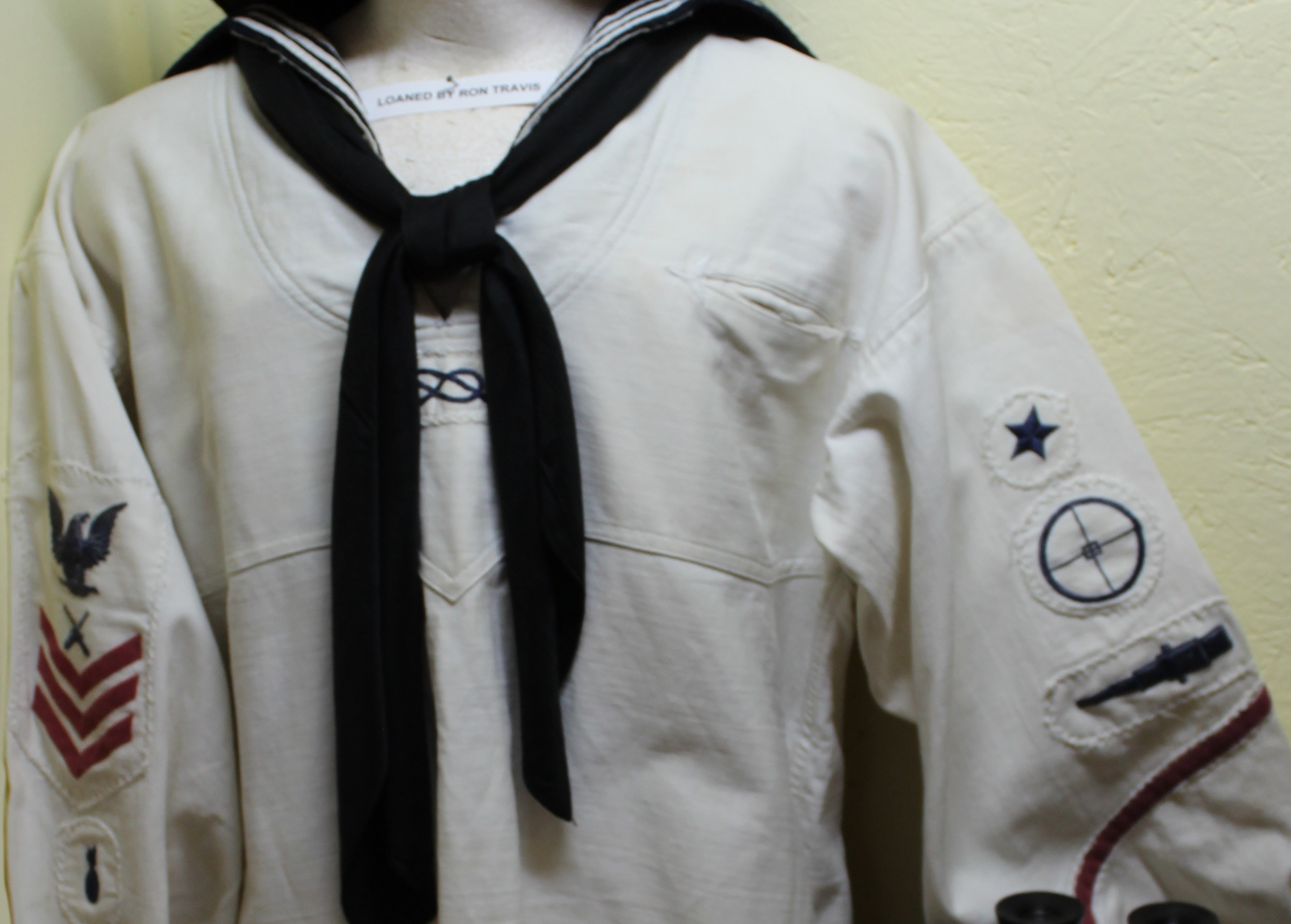
The "Dress White uniform" was intended for full dress occasions, during summer or in warmer climates. This uniform was worn by a U.S. Navy Petty Officer Gunner's Mate First Class "E6". Gunner's mate (GM) is a designation given to enlisted sailors who either satisfactorily complete initial Gunner's Mate "A" school training, or showing competence in the field of ordnance. The Bomb underneath the crow indicates a Seaman Gunner, and the best explanation could come up with was an individual who went into the Gunner's Mate rate and had completed his initial training on the gun systems.
Badges on the Navy World War II White uniform

Chief Gunners Mate: A sailor rated to command a turret on a Navy warship. The history of Gunner’s Mates began officially in the United States in 1794 with the formal establishment of the US Navy. Masters of cannon, shot, and small arms and ammunition. They are, were, and have been the thing that separates a “ship” from a “warship.
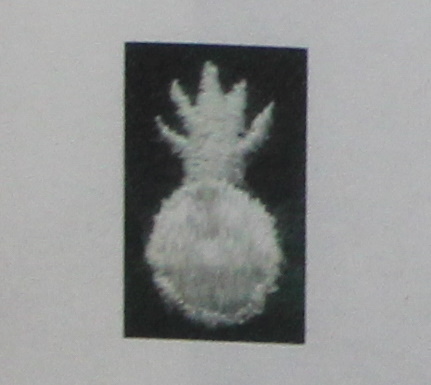
Seaman Gunner: an enlisted man (as in the U.S. Navy) passing through courses of instruction in such matters as the construction and handling of ordnance, torpedoes, explosives, or electricity.

Former Apprentice: Apprentices boys (wear a figure of eight knote badge) entered the Navy between the ages of 14 and 18 and served until their 21st birthday. Apprentice boys were introduced during the period 1875 - 1880 and lasted only until 1904. People who were in this program apparently were allowed to remain on active duty until their enlistments were up, or until they retired.
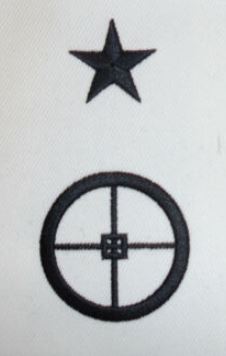
Gun Pointeer First Class: an enlisted man (as in the U.S. Navy) passing courses of instruction on gunnery fire control system.
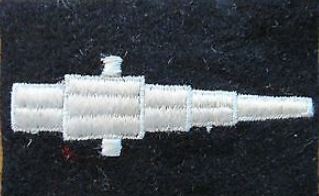
Gun Captain: A man regularly detailed by the commanding officerr of a vessel as a gun captain, except of a secondary battery gun (less than four inch caliber), shall wear the distinguishing mark with axis horizontal muzzle pointing foward, midway between the shoulder aqnd elbow of the left sleeve.
Service Stripe - 4 years
Rasher (SS-269)

USS Rasher "SS-269" a "Gato class" fleet submarine was laid down on 4 May 1942 in Manitowoc, Wisconsin; launched 20 December 1942. Following builder's trials in Lake Michigan, Rasher was decommissioned and towed down the Mississippi on a floating dry-dock. After recommissioning and fitting out in New Orleans, the new submarine trained in the Bay of Panama, departed Balboa 8 August 1943, and arrived at Brisbane, Australia, on 11 September. The USS Rasher began her war patrol in November 1943. The USS Rasher was credited with sinking 99,901 tons of Japanese shipping, the third highest total for US submarines in World War II.
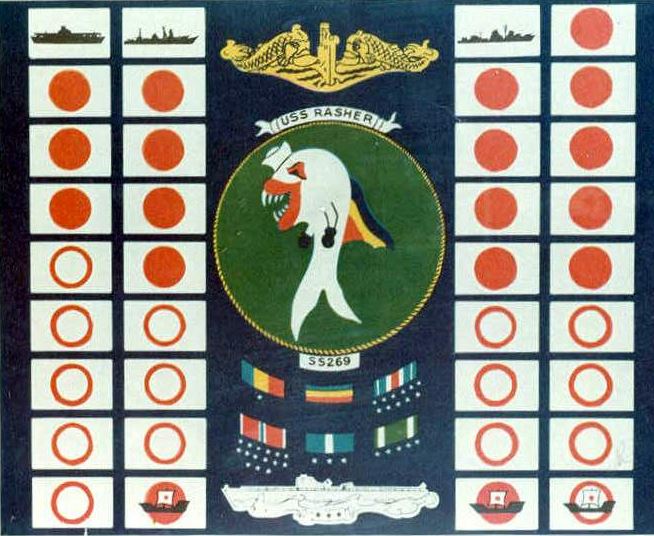
Commemorative Jacket Patch which was modeled after the Battle flag of the USS Rasher
The USS Rasher sank 19 Japanese ships : 1escort carriers IJN Taiyō, (17,830 tons), 2 destroyers and 16 merchant shiips for 99,901 total tonnage.
Navy insignia in front of Gato Class submarine

Sleeve Insignia, Radioman Chief Petty Officer (Rate) (RMC) (Enlisted Paygrade E-7)
Shoulder Board, Medical Officer, Lieutenant Junior Grade (LTJG) (Officer Paygrade O-2)
Shoulder Board, Line Officer, Commander (CMDR) (Officer Paygrade O-5)
U.S. Navy Service Stripe - 4 years The United States Navy and United States Coast Guard authorize one stripe for each four-year period of duty. The service stripes are authorized for wear by enlisted personnel on the lower part of the sleeve of a uniform to denote length of service. Service stripes vary in color. In cases where a disciplinary infraction has occurred, the service member is not denied a service stripe but simply is issued the standard red or black stripe. If no Non-Judicial Punishment (NJP, also called Captain's Mast) or Courts Martial after 12 consecutive years of Good Conduct has been served, then Gold Service Stripes and Rate Symbols are issued (using gold thread).
U.S. Navy 3 inch/ 50 Shell.
This is a Navy 3 Inch/50 shell weight is 24 lb . The 3"/50 caliber naval gun terminology indicates the gun fired a projectile 3 inches (76 mm) in diameter, and the gun barrel is 50 calibers long (barrel length is 3 in × 50 = 150 inches.) Different guns identified by Mark numbers of this caliber were used by the U.S. Navy from 1900 through to 1990 on a variety of combatant and transport ship classes.
The projectile (the top part of the shell) has a weight of 13 lb. The Black tip indicates Armor Piercing and Yellow band indicates High Explosive projectile, This is used as a defensive weapon abord Naval vessels, at a longer range (up to a max rang of 14,600 yards). The 3 inch/50 shell can also fire High Explosive (HE), and White Phosporus (WP) projectiles.
The 3 inch/50 Gun , is one of the smaller defensive guns aerboard naval vessels. The only other smaller defensive weapons are the 20 mm multiple barrell (pom-poms) that usually ring the side of the ship. these guns are capable of firing multiple rounds of ammunition at the enemy aircraft. (nickname for the 20 mm cannon is (Pom-Pom) , by the sound it makes when firing.
The USS Enterprise christening Dinner Plate 
The USS Enterprise christening Dinner Plate which was made in 1960. The plate was gifted to the US Veteran's Museum by Margaret and Gary "Mike" Rose on 10/21/2022.



